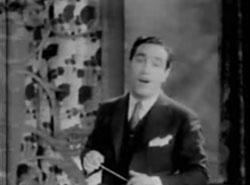 The Vitaphone musical short Ben Pollack & His Park Central Orchestra (1929) was found & restored at his own expense by Canadian vintage jazz afficianado Joe Showler.
The Vitaphone musical short Ben Pollack & His Park Central Orchestra (1929) was found & restored at his own expense by Canadian vintage jazz afficianado Joe Showler.
Ben Pollack tells us, "We are going to play 'My Kind of Love,'" & his little orchestra goes immediately into the number, written by Louis Alter & Jo Trent. Brass & violins mix with a bit of conflict as the guitarist & a trumpeter in back take turns singing the opening lines, intentionally not well.
The trumbone player stands quickly & interrupts, "Say, say, would you kindly tell me what in the world you're singing about?" The guitarist replies, "I'm singing about the girl I love."
The trumbonist, who is none other than a young Jack Teagarden, asks the same question of cornetist Jimmy McPartland on his left (our right) & gets the same answer.
Teagarden then asserts they don't know what they're talking about. "Benny, tell 'em about that girl you used to have." Ben Pollack then begins to sing the song in earnest. It's a typical croony Roaring Twenties ballad, & Pollack's pretty good at delivering it.
Trumbonist Teagarden with slicked-back hair does a couple verses in slurry bar-room manner, then the guitarist stands & sings part of it in a stentorial way. There follows an instrumental interlude headed up by that cool trumbone, but also a couple moments for (guess who!) Benny Goodman on clarinet. The number has gone from ballad to more of a Dixieland flavor before Ben finishes the lyrics.
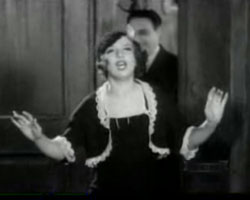 The Vitaphone "Melody Masters" one-reeler The Audition (1933) opens with Phil Emerton's Diamonds playing in what looks like the entryway to a theater, with theatrical posters behind them on the wall.
The Vitaphone "Melody Masters" one-reeler The Audition (1933) opens with Phil Emerton's Diamonds playing in what looks like the entryway to a theater, with theatrical posters behind them on the wall.
They're auditioning for Mr. Rogers, who takes Phil into a side room, his office, giving Phil some discouraging words about bookings.
Meanwhile the orchestra continues out in the hall. The uncredited vocalist begins the lyrics for "What a Life, Trying to Live Without You" written by Louis Alter & Charlotte Kent. It was a big hit a year earlier from numerous performers including the Coon Sanders Nighthawks Orchestra, Ruth Etting, Helen Morgan, Isham Jones & His Orchestra, & continued to be a band standard for at least a decade to follow, though it's a mite dated now.
Mr. Rogers insists the band needs a novelty act to spice up a show, & something with more sex appeal, too, specifically, a girl singer. By the strangest of coincidence, Hannah Williams strolls in, & Rogers tells Phil to get his band to play "Get Happy" for her to see if the band was good enough to back such a singer as Hannah.
She gives a very actorly rendition of Harold Arlen & Ted Koeher's hot-jazz show tune, dancing & singing with joyful personality, tossing in a bit of scat. The song was introduced to the public in 1930 by Ruth Etting, & it never ceased to be a popular band tune, eventually becoming strongly associated with Judy Garland after she sang it in Summer Stock (1950).
Hannah was a song, dance, & comedy star of Broadway, & she'd sung with Ben Pollach's orchestra in the Roaring Twenties. Boxer Jack Dempsy was her second of three husbands. She's obviously a great talent, but never quite made it in the cinema. Vitaphone shorts were used as advanced screen tests for talent under consideration, & someone clearly made a negative decision on Hannah as well as Phil Emerton.
Back in Rogers' office, Hannah has some ideas for the band too, & thinks they should do a number with "a southern setting." "Oh, you mean like 'Down by the Levy'?" asks Rogers. "Yes sir, and yazzuh!" Hannah replies. Rogers says he's eager to put the band members on a levy set, put them in overalls, & "blacken 'em up!"
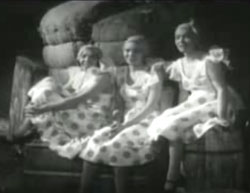 We then cut to a southern setting. The band is in a farm yard in striped coveralls & sun hats, not blackfaced thank god, playing woodenly "Carry Me Back to Old Virginny." We then cut to a southern setting. The band is in a farm yard in striped coveralls & sun hats, not blackfaced thank god, playing woodenly "Carry Me Back to Old Virginny."
It's cute, but if this really represents what Phil's band was into, there's no confusion as to why they aren't remembered today.
With a jump-cut to stock footage of a riverboat on the Mississippi, the scene jumps again to a set, this one presumedly on deck. Sitting amidst bales are three gals harmonizing.
These gals billed themselves as the Three X Sisters, namely Jessie, Pearl & Violet Hamilton. They sing Maceo Pinkard & Billy Rose's composition "Here Comes the Showboat."
The Three X Sisters had been performing since 1924 in Vaudeville & on Broadway, starting out as Helen "Betty Boop Stole Her Voice" Kane's back-up singers, then toured successfully & introduced a few Rodgers & Hart numbers.
The Roaring Twenties were their heyday & though they continued to perform into the 1940s, they had pretty much faded & never rose even so high as the nearly-big.
Judging them by this one tune, they were just a little too cutesie to age well. As kids it would've been super that they sounded like singing kittens, but that sound would be cloying from mature women. They interpret the tune rather oddly as western swing despite its southern theme. The Boswells or Broxes they were not.
Back in the farmyard, a trumpet strikes up a military tune & out run acrobatic tapdancers billed as "Larry & Larry." The dance & backflip to minimalized background music from the band. The two Larries begin immediately to do what for all the world looks like breakdancing for along with their flying tap antics we get flips & whirling on their backs & shoulders.
The Audition closes back in Mr. Rogers' office with a thin joke. When all is said & done, really only Hannah Williams deserved a wider reputation than any of these forgotten performers achieved, but it's even so an entertaining wee film.
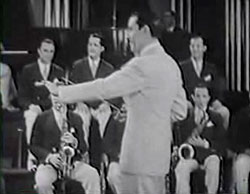 Rube Bloom's classic hot jazz composition "Song of the Bayou" opens the Vitaphone one reel musical short Abe Lyman & Band (1933), starring a popular orchestra from the 1920s through 1940s.
Rube Bloom's classic hot jazz composition "Song of the Bayou" opens the Vitaphone one reel musical short Abe Lyman & Band (1933), starring a popular orchestra from the 1920s through 1940s.
A clarinet so early in "Song of the Bayou" is brilliantly played. A xylophone solo is joyful. A train is racing forward on a back-projection screen beyhind the band, inducing the band to play the sounds of trains.
The arrangement is busy-busy & noisy, trying a little too hard to be attention-holding with never so much as five seconds before some change or another. It's really too busy to be any good.
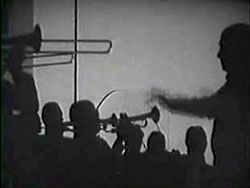 The second number begins with the band in silhouette, visually more effective than the back-projected train, but showing the filmmakers wanted to do a little more than just capture a concert. The second number begins with the band in silhouette, visually more effective than the back-projected train, but showing the filmmakers wanted to do a little more than just capture a concert.
The number is "Farewell Blues" composed by Elmer Schoebel, Paul Mares & Leon Rappolo.
It's another overly busy arrangement but with its slower tempo can't shift too annoyingly quick, & it settles down for a bit while the silhouetted boy on a hill turns into a dancer & a vocalist interprets the lyrics with the kind of stentoriality required of poorer vaudeville houses with bad acoustics requiring singers to yell.
The silhouetted dancer vanishes after enacting anguish & labor, then the back-projection shows a baptismal scene cribbed from the black cast film Halleluja (1929).
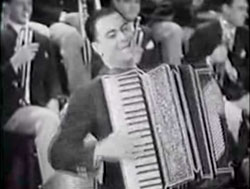 Other bits & patches of African American doings are shown along with the white band's attempt at a round of "colored" chorus singing, with a tenor vocal lead rising above the rest. Other bits & patches of African American doings are shown along with the white band's attempt at a round of "colored" chorus singing, with a tenor vocal lead rising above the rest.
It's the best of the short film's three numbers, attempting to be operatic in scope. But it needs some forgiveness of the standard racism of the time. Additional moments of the uncredited dancer are great, & he's snatched from some black-cast film as well.
The last number is plainly delivered without film tricks. It's "Milenberg Joys" written by Leon Rappolo, Paul Mares, Jelly Roll Morton & Walter Melrose.
It's a lively arrangement but not recklessly speedy & over-arranged as "Song of the Bayou" had been. There's an accordion solo early in the arrangement, jazzed up so thoroughly it lacks the usual dork factor of accordions.
Various segments of the orchestra get their moment in this great rag number -- two trombones, then three violins, then three trumpets. A hysterically wodnerful trombone solo by a chap whose muted instrument sounds like a gigantic kazoo, & he hops about like this is the most fun on earth. This is none other than Al "Rubberlegs" Norman who can also be seein in Paramount on Parade (1930) & in King of Jazz (1930).
copyright © by Paghat the Ratgirl
|
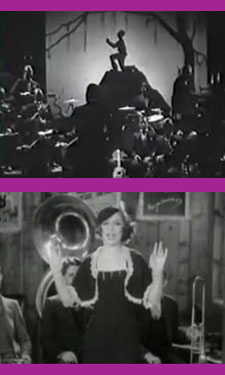


 We then cut to a southern setting. The band is in a farm yard in striped coveralls & sun hats, not blackfaced thank god, playing woodenly "Carry Me Back to Old Virginny."
We then cut to a southern setting. The band is in a farm yard in striped coveralls & sun hats, not blackfaced thank god, playing woodenly "Carry Me Back to Old Virginny."
 The second number begins with the band in silhouette, visually more effective than the back-projected train, but showing the filmmakers wanted to do a little more than just capture a concert.
The second number begins with the band in silhouette, visually more effective than the back-projected train, but showing the filmmakers wanted to do a little more than just capture a concert. Other bits & patches of African American doings are shown along with the white band's attempt at a round of "colored" chorus singing, with a tenor vocal lead rising above the rest.
Other bits & patches of African American doings are shown along with the white band's attempt at a round of "colored" chorus singing, with a tenor vocal lead rising above the rest.